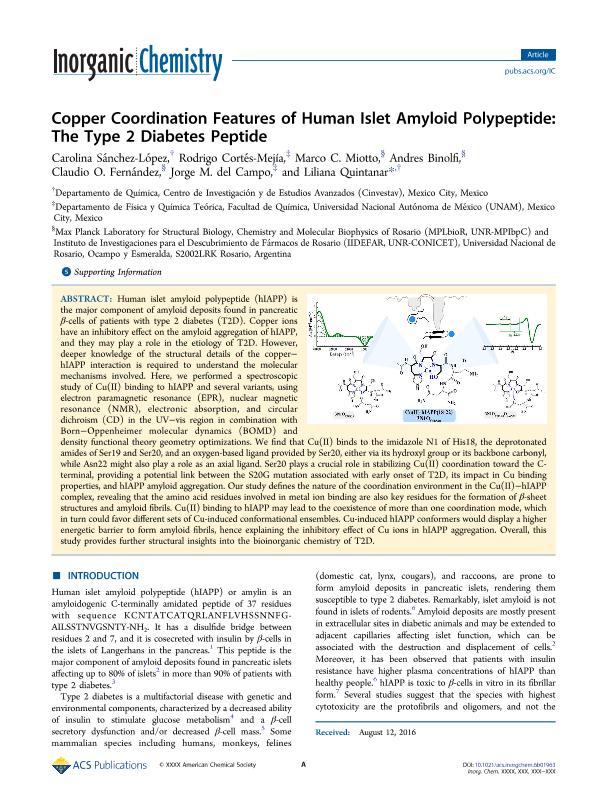Artículo
Copper Coordination Features of Human Islet Amyloid Polypeptide: The Type 2 Diabetes Peptide
Sánchez López, Carolina; Cortés Mejía, Rodrigo; Miotto, Marco César ; Binolfi, Andrés
; Binolfi, Andrés ; Fernandez, Claudio Oscar
; Fernandez, Claudio Oscar ; Del Campo, Jorge M.; Quintanar, Liliana
; Del Campo, Jorge M.; Quintanar, Liliana
 ; Binolfi, Andrés
; Binolfi, Andrés ; Fernandez, Claudio Oscar
; Fernandez, Claudio Oscar ; Del Campo, Jorge M.; Quintanar, Liliana
; Del Campo, Jorge M.; Quintanar, Liliana
Fecha de publicación:
10/2016
Editorial:
American Chemical Society
Revista:
Inorganic Chemistry
ISSN:
0020-1669
Idioma:
Inglés
Tipo de recurso:
Artículo publicado
Clasificación temática:
Resumen
Human islet amyloid polypeptide (hIAPP) is the major component of amyloid deposits found in pancreatic β-cells of patients with type 2 diabetes (T2D). Copper ions have an inhibitory effect on the amyloid aggregation of hIAPP, and they may play a role in the etiology of T2D. However, deeper knowledge of the structural details of the copper-hIAPP interaction is required to understand the molecular mechanisms involved. Here, we performed a spectroscopic study of Cu(II) binding to hIAPP and several variants, using electron paramagnetic resonance (EPR), nuclear magnetic resonance (NMR), electronic absorption, and circular dichroism (CD) in the UV-vis region in combination with Born-Oppenheimer molecular dynamics (BOMD) and density functional theory geometry optimizations. We find that Cu(II) binds to the imidazole N1 of His18, the deprotonated amides of Ser19 and Ser20, and an oxygen-based ligand provided by Ser20, either via its hydroxyl group or its backbone carbonyl, while Asn22 might also play a role as an axial ligand. Ser20 plays a crucial role in stabilizing Cu(II) coordination toward the C-terminal, providing a potential link between the S20G mutation associated with early onset of T2D, its impact in Cu binding properties, and hIAPP amyloid aggregation. Our study defines the nature of the coordination environment in the Cu(II)-hIAPP complex, revealing that the amino acid residues involved in metal ion binding are also key residues for the formation of β-sheet structures and amyloid fibrils. Cu(II) binding to hIAPP may lead to the coexistence of more than one coordination mode, which in turn could favor different sets of Cu-induced conformational ensembles. Cu-induced hIAPP conformers would display a higher energetic barrier to form amyloid fibrils, hence explaining the inhibitory effect of Cu ions in hIAPP aggregation. Overall, this study provides further structural insights into the bioinorganic chemistry of T2D.
Palabras clave:
Copper
,
Diabetes
,
Bioinorganic
,
Biophysics
Archivos asociados
Licencia
Identificadores
Colecciones
Articulos(CCT - ROSARIO)
Articulos de CTRO.CIENTIFICO TECNOL.CONICET - ROSARIO
Articulos de CTRO.CIENTIFICO TECNOL.CONICET - ROSARIO
Citación
Sánchez López, Carolina; Cortés Mejía, Rodrigo; Miotto, Marco César; Binolfi, Andrés; Fernandez, Claudio Oscar; et al.; Copper Coordination Features of Human Islet Amyloid Polypeptide: The Type 2 Diabetes Peptide; American Chemical Society; Inorganic Chemistry; 55; 20; 10-2016; 10727-10740
Compartir
Altmétricas



